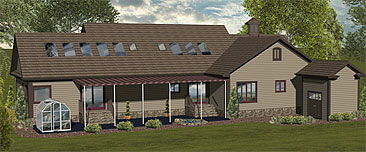Creating a Home Garden
We're all aware of the health benefits of eating fresh vegetables, so why not grow your own by starting a small garden. It's the perfect way to complement your appetite for cooking a great gourmet meal.
If this is your first vegetable garden then you'll want to start out with a small garden that is no larger than 8' x 10'. You don't want to plant a garden that is too large for you to manage. You can always expand your garden down the road if you find you have a real 'green thumb.'
Choose a location that receives as least six hours of sun a day. Northern gardeners should insist on full sun to ensure a healthy garden. Once you've chosen the location and size you need to work up the soil with a tiller (you can rent one for the day for around $25-$50 depending on where you live).
This new, innovative ENERGY STAR
® house plan features a 6' x 13' greenhouse to make gardening enjoyable and convenient.
Next, you'll want to test the soil to determine if it's mostly clay, sand or a sandy loam. The latter is the best. If you pick up a handful of dirt and squeeze it in a ball and it crumbles when you let it go then you've got sandy loam. If you're not sure you should have it tested at a local laboratory or purchase a soil test kit (around $75). You should also have your soil tested for proper pH levels and major nutrients like nitrogen, potassium and potash.
If you're stuck with a predominantly sandy or clay soil, you have several options to improve your soil — bring in some topsoil, amend the soil with organic compost or design a raised bed garden. It may take a few seasons to improve the quality of your soil, so be patient.
This
house plan took first place in The House Designers Annual ENERGY STAR/Green House Plan Competition and features a greenhouse and gorgeous landscaping to accent the home's exterior.
Now comes the fun part — selecting the vegetables you want to plant in your new garden. Seeds and container vegetables are available online, through catalogs and in garden stores. Your biggest challenge is going to be deciding from the 100s of variety of vegetables available. Be sure to select high quality seeds to ensure successful growth and freshness. You don't want to spend hours preparing a garden and then purchase 10 for $1 seeds, which will most likely not grow properly, if at all. Since you're trying to maximize your chance of success with your first garden, this is not the area to pinch pennies. For example a package of 40 seeds for Burpee® tomatoes is $3.95, not a high cost to pay for luscious tomatoes.
Since you're starting out with a small garden, you may want to avoid space hogs like corn, squash and pumpkin. Look for hybrid vegetables that don't take up as much space. Easy to grow crops include onions, peas, beets, rutabaga and zucchini squash, which can also be planted early.
Tomatoes and peppers need to be started from seed indoors about 8 weeks prior to planting time or purchased as transplants (a bit more costly). Be sure to space things according to the instructions on the packets for proper growth. Plant tender crops like tomatoes, squash, beans and watermelon after the last frost dates have passed.
Don't forget to protect your garden from unwanted dinner guests by enclosing your garden with wire mesh. If your garden is properly spaced, weeded and fertilized you shouldn't have a big insect problem, but be sure to check frequently for evidence of snacking. You need to identify the insect before you can properly eliminate them.
Be sure to harvest your vegetables when ripe so you can enjoy the experience of eating fresh, crisp vegetables you grew yourself!
Bon Appétit!
Design Tip
If you find yourself with an insect problem, you should choose natural, organic pesticides instead of synthetic chemicals. Organic pesticides are usually plant-based and are much safer for the environment and for you and your family. You could also remove insect pests by hand or release insects such as lady beetles or praying mantis into your garden to eat the pesty bugs.



.png)
.png)




